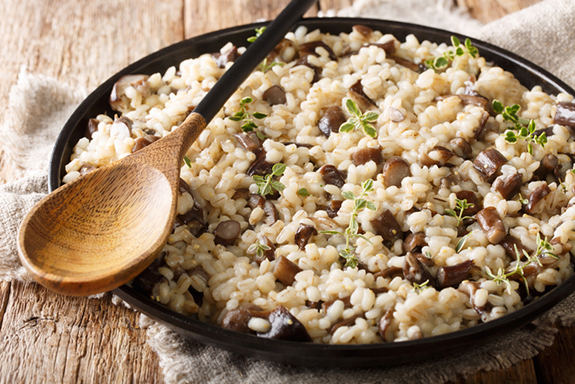Delicious, Nutritious Alternatives to Mashed Potatoes and Other Starches
The original Thanksgiving dinner was nothing like the traditional feast most of us enjoy today. The Pilgrims served lots of fish, a bit of wild fowl, and there was nary a potato in sight since they were expensive, rare and considered exotic. The modern-day holiday menu in most American homes now features potatoes, though they aren’t exactly considered exotic — in fact, the meal might benefit from a bit of creativity and a great place to start is with the addition of unusual and healthy whole grains. There are many delicious ways to adapt these, and they’re incredibly good for you, too, with lots of fiber and important nutrients, including selenium, potassium and magnesium.
For suggestions on how to incorporate whole grains into the feast, I called nutritionist Jane Kirby, RD, CD, CCP, author of several award-winning nutrition books and cookbooks, and now co-owner of the Nitty Gritty Grain Company of Vermont, producers of certified organic whole-grain products.
Pearl Barley, Wheat Berries for Stuffing
Barley: Kirby’s first suggestion for a Thanksgiving side dish is barley, preferably pearl barley, which is smaller and cooks faster. Though it is not as high in protein as other grains, its high fiber content makes it helpful in lowering cholesterol… and barley’s distinctive flavor is lovely in stuffing, says Kirby. Cook for 40 minutes, as you would brown rice, fold into sautéed onions, sage and sausage with any of your other stuffing ingredient favorites. Barley also is excellent as a substitute for rice in bean dishes — use black or small white beans plus sage, parsley and sautéed onions.
Wheat berries: Wheat berries, which have the same nutritional value as whole wheat, are another good choice for a stuffing base, says Kirby. Choose wheat berries from soft winter wheat, which is starchier and easier to cook with than the hard, red wheat later in the season. Soak them overnight, drain, add fresh water to cover, and cook as you would pasta (to al dente) about 25 minutes. (Be sure to cook long enough that the berries are soft and not chewy.) Drain the excess water and prepare the stuffing in the same manner as with barley.
Replace Mashed Potatoes with…
Cornmeal: Whole-grain cornmeal was beloved by the Pilgrims and is the key ingredient in Indian corn pudding, which remains a popular dish in some regions. It is a good source of protein, folate, magnesium and phosphorus and is gluten free. Whole-grain cornmeal has a rich corn flavor and is excellent — if a bit decadent — in a cheesy casserole that you can serve instead of mashed potatoes. It may be hard to find whole-grain cornmeal in supermarkets — Kirby’s Nitty Gritty Grains and Arrowhead Mills are two brands.
Millet: Millet, which is actually a seed, is similar to grains and is a healthful alternative, rich in magnesium, phosphorus and manganese. Millet makes a nice replacement for potatoes when blended with butter, parsley and Parmesan or served in a casserole with tomatoes, eggs, cream, cheese and butter. With a neutral, even bland taste, it readily takes on the flavors of foods cooked with it. Other pluses — it is gluten-free and takes only about 20 minutes to cook. When it’s time for leftovers, Kirby says millet is great in turkey and vegetable soups and stews.
Quinoa for Leftovers
Quinoa: Quinoa (pronounced keen-wah), tiny pearllike seeds from the Andean Mountain regions of Peru, Chile and Bolivia, is another gluten-free easy-to-cook choice. It’s less robust than other grains, so be careful not to overcook it or it will turn mushy. Quinoa is abundant in the nutrients manganese, iron and phosphorus. It is a complete protein, especially rich in the amino acid lysine. While it has its own gentle nutty flavor, quinoa is an especially adaptable base for many different flavors, says Kirby. This makes it ideal for mixing with all kinds of peppers — for example, a side salad with chopped peppers, olive oil, cilantro, jalapeño, or any of your favorite herbs or spices.
Buying & Storage Tips
All of these grains are available in health-food and specialty stores, such as Whole Foods — but, if you aren’t buying them in packaged form, be sure you buy them only in a market that does a brisk business. If whole grains sit a long while, they may turn rancid, so Kirby suggests checking freshness dates or sniffing grains before you buy.
Kirby also has a few words of caution about storage. Always keep grains in tightly sealed plastic bags or containers, and store them in the freezer — again so they don’t turn rancid. Freezing also preserves nutrients and eliminates infestation by any pesky bugs. She adds that grains are not always pre-washed before they go to market, so a quick rinse in a colander before you cook grains is a wise practice.
Whether you try these recipes at Thanksgiving dinner or at another occasion, I suspect you’ll be thankful you gave them a try.


